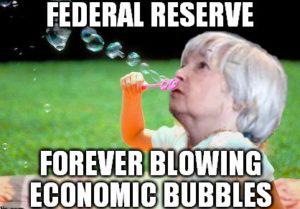
Yikes! $450.3 million for Leonardo da Vinci’s “Salvator Mundi” sold on Wednesday night at Christie’s auction, shattering the high for any work of art sold at auction. It far surpassed Picasso’s “Women of Algiers” which fetched $179.4 million at Christie’s in May 2015. It also far surpassed the $127.5 million that Russian billionaire oligarch Dmitry E. Rybolovlev paid for it in 2013. In 1958, the painting sold for £45 because it was believed this was not an authentic da Vinci but merely one done by one of his students. In 2005, an art dealer purchased it for $10,000. There have been numerous questions surrounding its authenticity and the fact that it had at times been restored. The painting dates from around 1500 and is believed to have been commissioned for King Louis XII of France. The current buyer is unknown.
Bubbles, bubbles everywhere. There are bubbles in the stock market, the bond market, the corporate bond market, auto loans, student loans, real estate, government debt, art and collectibles, and yes, Bitcoin! But it also begs the question— why isn’t there a bubble in commodities and especially gold?
Fed Chairman Janet Yellen Blowing Bubbles

The finger is easy to point at the Fed and its fellow central banks, the ECB and the BOJ. Look at the years of artificially suppressed interest rates and quantitative easing (QE) that have resulted in producing only anemic economic growth but massive inflation of financial and other assets. A look at the massive growth in the assets of the major central banks tells the story.

Source: www.stlouisfed.org
Since the end of 2007, the Fed’s balance sheet has ballooned by $3.6 trillion or 300%, the ECB’s balance sheet has shot up by €2.9 trillion or 190%, while the BOJ’s balance sheet has exploded by ¥406.7 trillion or 365%. Global debt has exploded as well. According to studies, global debt has grown from roughly $149 trillion in 2007 to about $217 trillion today (some show as high as $230 trillion) an increase of 46%. Global debt to GDP stands at around 327% with some countries such as Japan and the United Kingdom exceeding with a debt to GDP ratio in excess of 600% (Note: debt refers to all debt—governments, corporations, and households). The U.S. is at 332%.

Source: www.iif.com, www.bis.org, www.haver.com
China has been the largest source of global debt growth. In 2007, Chinese debt (all debt) to GDP stood at around 150%. Today it is over 300%. China’s corporate sector has been the biggest source of growth. Emerging market debt has also grown rapidly with much of it borrowed in US$. Borrowing in US$ works well if the borrower’s home currency rises against the US$ but for many, it has been the opposite with their home currency falling sometimes sharply against the US$. That makes the debt borrowed in US$ even more expensive. Defaults could loom and that has become a constant worry.
But massive growth in debt has been seen in all sectors. As 2017 nears an end there has been a considerable rise in downgrades of debt from the rating agencies including S&P, Moody’s, and Fitch. All sectors have been impacted, both corporate and government. In the U.S., the Fed has issued warnings about sub-prime automobile loans and student debt. In Canada, the Bank of Canada has constantly issued warnings about the high level of household debt.
Massive growth in debt and central bank balance sheets have helped feed the bubbles. There is simply too much cash sloshing around the world. This helps inflate the assets. But is any of it being invested wisely? Hardly. The U.S. has spent an estimated $4.3 trillion on wars since 2003. Yet in the U.S. today all they talk about is tax cuts that will primarily benefit the wealthy and add more to the national debt. U.S. corporations have billions stashed overseas but it is not being invested. China seems to be putting some of their money to use through the Asian Infrastructure Bank, a bank being set up to rival the IMF and the World Bank. There is also China’s “New Silk Road” that will cross Asia into Europe. No wonder today that the U.S. sees China as the main threat to the U.S.’s global economic hegemony and the Chinese Yuan equally as a threat to US$ hegemony.
There is an old saying that you cannot borrow your way to prosperity. Yet that is exactly what we have done. And evidence of too much money sloshing around in the financial system was highlighted by this week’s sale of “Salvator Mundi.” It is a sign of excess. We live in an illusion of wealth backed by debt. All major depressions and financial crises have their basis in debt collapse. Is this time any different? We doubt it. It is a matter of when not if.
Bitcoin Watch!

Source: www.coindesk.com
We are getting a headache. Yes, we are getting a headache watching Bitcoin. We are now suffering from severe whiplash following last week’s plunge that saw Bitcoin fall from $7,879 to $5,507 or 30% in the space of five days only to turn around and rise to a new record high of $7,998 or 45% five days later. Whew! Are you exhausted yet?















